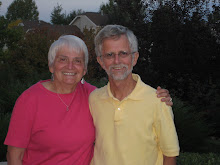We got up and headed back across the Columbia River to Oregon and had a delightful breakfast with Debbie. Lots of catching up and just a generally good time. We then returned to Vancouver, WA and visited the Vancouver National Historic Reserve.
This Reserve brings together a national park, the region's first military post, an international fur trade emporium, one of the oldest operating airfields, the first national historic site west of the Mississippi River, and a waterfront trail and environmental center on the banks of the Columbia River. Obviously, a very interesting place. We only visited two of the sections. We began across the street from the Visitor's Center at Officer's Row of Vancouver Barracks. It has a long history, but the most significant time was in the 1930's when Vancouver once again rose to national prominence under Gen. George C. Marshall, who commanded both the department and the Civilian Conservation Corps' main training facility in the Pacific Northwest.
The Parlor
We then drove down to the Ft. Vancouver National Historic Site. The 200-acre site was the center of the Hudson's Bay Co's fur-trading empire from 1825-60. Several of the buildings have been reconstructed. We were fortunate to run into a docent with keys and she gave us a wonderful tour.


Dr. John McLoughlin was the Chief Factor of the area for The Hudson Bay company. He ejoyed great autonomy since his superiors were across the continent. When the immigrants coming across the Oregon Trail began arriving, he was of great aid to them, even though it was strictly against company policy. This was his dining room where he entertained influential people of the time.
 This was the children's bedroom for one of the
This was the children's bedroom for one of the
officers of the Hudson Bay Company.
 The pelt storeroom for the Hudson Bay company. These pelts would be traded for food and supplies by trappers, Indians and others and then shipped to England for hats and finery. Beaver was the main one, but there were 10 or so varieties of pelts to see and feel. They would take the pelts and put them in a press to compress 100 or so pelts into these packages that were then wrapped in leather.
The pelt storeroom for the Hudson Bay company. These pelts would be traded for food and supplies by trappers, Indians and others and then shipped to England for hats and finery. Beaver was the main one, but there were 10 or so varieties of pelts to see and feel. They would take the pelts and put them in a press to compress 100 or so pelts into these packages that were then wrapped in leather.

 This was the children's bedroom for one of the
This was the children's bedroom for one of theofficers of the Hudson Bay Company.
 The pelt storeroom for the Hudson Bay company. These pelts would be traded for food and supplies by trappers, Indians and others and then shipped to England for hats and finery. Beaver was the main one, but there were 10 or so varieties of pelts to see and feel. They would take the pelts and put them in a press to compress 100 or so pelts into these packages that were then wrapped in leather.
The pelt storeroom for the Hudson Bay company. These pelts would be traded for food and supplies by trappers, Indians and others and then shipped to England for hats and finery. Beaver was the main one, but there were 10 or so varieties of pelts to see and feel. They would take the pelts and put them in a press to compress 100 or so pelts into these packages that were then wrapped in leather.
This was the general store where Indians, settlers in the area and travelers could shop for supplies. There were also some volunteer black smiths working the shop. It was a fascinating tour....a different aspect of life here than we had seen before.


